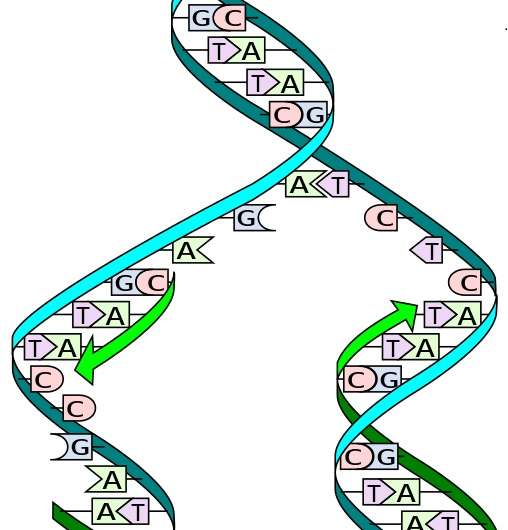Eukaryote process of programmed fork arrest determined

A research collaboration between the Medical University of South Carolina, the Institute of Human Genetics in France, and Howard Hughes Medical Institute at Rockefeller University has revealed the means by which cells accomplish programmed DNA replication arrest. Their results in the June 13, 2016 issue of the Proceedings of the National Academy of Sciences describe the conditions that require a replication fork to stop, and in doing so explain why terminator sites on DNA don't always successfully stop a replication fork. It is a matter of different proteins working together to calibrate fork movement.
In a process similar to a rail system in which trains follow a coordinated schedule of stops, cells use programmed fork arrest to halt the replication machinery at predetermined places along the DNA strand called terminator sites. Terminator sites minimize collision between replication machinery and transcription machinery traveling along the same track of DNA by blocking both processes at the halted fork. A collision might otherwise cause the DNA strand to break or become unstable. Programmed fork arrest also prevents replication and transcription machinery from running constantly, which helps conserve the amount of energy a cell needs to function.
These measures control cell life span and preserve genome stability, according to Deepak Bastia, Ph.D., Endowed Chair for Biomedical Research in the MUSC Department of Biochemistry and Molecular Biology and co-senior author of the study.
"Programmed fork arrest interconnects DNA replication with aging, transcription and gene differentiation," says Bastia. "You have to maintain the genome so that genetic integrity and life span is maintained."
During DNA replication and transcription, DNA polymerases travel along the double helix. During replication, one enzyme, a helicase, unwinds the double-stranded DNA into two single strands that travel behind it as it moves. DNA polymerases serve as templates on each single strand, allowing synthesis of two double-stranded daughter copies from one parent DNA strand. The junction where double-stranded DNA is separated into two single strands is aptly called the fork.
Only large proteins called histones that bind tightly to DNA are guaranteed to stop a replication fork in its tracks. The replication fork machinery easily sweeps other DNA-bound proteins out of the way. In one sense, this process keeps replication moving smoothly along the DNA strand. But in order to fine-tune their life cycle, cells need a more precise measure to stop replication other than the bulky histones. It turns out that a protein called Fob1 resides at terminator sites on DNA and works intermittently to halt fork progression, much like a gate. Its biochemical signal is phosphorylation.
It is this process that Bastia and his colleagues worked out. DDK, one of the two major cell cycle dependent kinases that sense which phase of life a cell is in, is responsible for assembling a replication fork blockage on terminator sites where Fob1 is bound. During active replication, the replication machinery easily pushes Fob1 off the DNA track and continues past the terminator sites. However, when DDK phosphorylates the helicase that unwinds double-stranded DNA at the head of the fork, it initiates the formation of a protein-based landing pad that connects to the helicase. An enigmatic protein named "Timeless" then docks on the landing pad and restrains other helicases that would normally sweep Fob1 off of the DNA terminator sites ahead of the moving fork. The Fob1 gate then stops the replication fork as programmed.
Bastia's group showed this in yeast by genetically inactivating a component of DDK that is responsible for phosphorylating the helicase. In "chromosome combing" microscopy experiments, where single-stranded and double-stranded DNA were labeled with different colored fluorescent molecules and gently extended on coverslips, inactivated DDK failed to stop the replication fork. When active DDK was blocked from phosphorylating the helicase, Timeless protein could not reach the landing pad and the replication fork proceeded uninhibited. This physiologic program, which is similar across many organisms, is also likely to be conserved in humans, according to Bastia.
Bastia states that this new understanding will inform research on aging. Deciphering the means to prolong programmed fork arrest in healthy cells might eventually extend healthy life span in humans. "Aging is a disease," he says, "not a natural process."
More information: Deepak Bastia et al, Phosphorylation of CMG helicase and Tof1 is required for programmed fork arrest, Proceedings of the National Academy of Sciences (2016). DOI: 10.1073/pnas.1607552113
Journal information: Proceedings of the National Academy of Sciences
Provided by Medical University of South Carolina




















